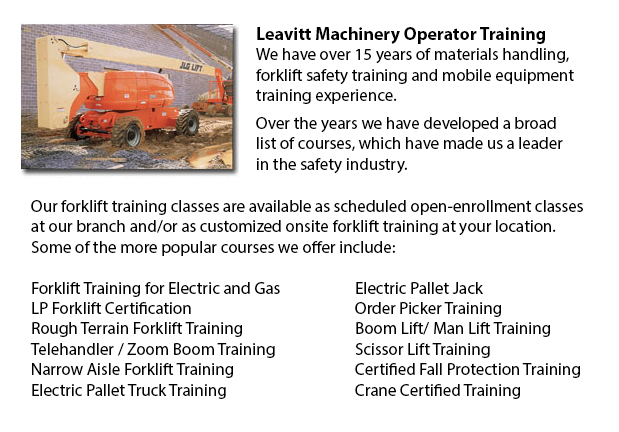
Manlift Training Richmond Hill - Various manlift training programs consist of the review and content of manlift devices. An important part of the course is the practicum where students show their knowledge and practical ability to safely operate a manlift. A prerequisite to Manlift training is the fall protection training, that can be incorporated in the training based on the particular requirements of the customer.
Course Content
The program includes the following areas of instruction: pre-shift equipment inspection and work area survey requirements; the impact of doing unsafe acts or utilizing unsafe machines, Review of load capacities, Lifting devise equipment definitions, the specific equipment requirements and safety decals, Review of related sections of the OSHA Standards as well as the CSA Standards and Review site specific Dangers, along with controls for safely using a lifting device.
Demonstration and Evaluation Content
Evaluation and demonstration content comprises: Proper personal protective equipment or likewise known as P.P.E. as needed; Using a signaler or a spotter when required; Utilizing a lift just on level and solid ground; Making use of the right fitting harness or fall arrest device; Using the lift with all other workers clear of the job place; Aware of load restrictions etc. and other specs as set out by the manufacturer; Pre-shift work area survey and equipment check; Having all associated equipment stored safely on the lift platform; Isolating off the work place when major work projects are to be completed; and ensuring a safe and smooth operating speed for various plant conditions
Each of the trainees would undergo testing to make certain that they can safely operate their machinery.
Manlift Safety
As the manlift is capable of lifting materials and personnel more than 20 feet in the air, these machines pose a particular amount of risk and could be dangerous machinery if not utilized properly. As the danger is so apparent, lift operators and owners are careful to properly maintain their equipment and follow proper safety measures and operating procedures. The ratio of accidents involving this specific apparatus is fairly low.
The safe use of the manlift, boom lift and scissor lift is up to the operator of that machine. They must know all of the responsibilities that go with operating the machine and how to utilize the lift vehicle safely. The most basic safety features on the machinery are the operating handbook and safety decals. These show essential information regarding the operating procedures, safety machinery and maintenance.
Newer lift models would come along with instruction manuals and decals in place. Technically, the operating manual should be kept on the lift itself. If you are buying a used lift, it is important to ensure that the instruction manual is included and that essential decals haven't been painted over. The restraints which prevent operators from falling and the guardrails are other important safety features. These are mandatory and standard on all types of lifts.
-
Scissor Lift Certification Richmond Hill
Scissor Lift Certification Richmond Hill - Scissor lift platforms are utilized at work sites in order to allow tradespeople - like for example welders, masons and iron workers - to reach their work. Operating a scissor lift platform is usually second... More -
Narrow Aisle Forklift / Order Picker Training / Electric Pallet Jack / Electric Pallet Truck Training in Richmond Hill
A pallet jack is a model of equipment specialized in the transporting of pallets of many dimensions and weights. They might be utilized as an appendage for lift trucks, cranes and other types of heavy machinery or be used on their own. Pallet jacks a... More -
Heavy Equipment Operator Certification Richmond Hill
Heavy Equipment Operator Certification Richmond Hill - The heavy equipment operator is a person who manipulates the controls and drives various kinds of big machinery. Heavy machinery is most frequently used on construction sites in order to deliver... More -
Loader Training Richmond Hill
Loader Training Richmond Hill - Why You Must Finish A Loader Training Course - Individuals wanting work in businesses that use lift trucks must undergo a Loader Training program prior to becoming a certified operator of a lift truck. There are lots o... More -
Fall Protection Training in Richmond Hill
There are many injuries at work associated to falling and a lot of fall-related deaths reported every year. Most of these instances could have been prevented with better training, better measures in place, and by correctly equipping personnel before... More -
Wheel Loader Training Richmond Hill
Wheel Loader Training Richmond Hill - Commonly, the various kinds of heavy equipment training are classed into 2 categories of machinery: those which have rubber tires and tracked vehicles. Tracked vehicles consist of items like cranes, bulldozers an... More -
Forklift Certification Schools Richmond Hill
Forklift Certification Schools Richmond Hill - Forklift Certification is mandatory in North America. Hence, forklift training programs are important both for companies and for people seeking jobs in industries as forklift operators. Forklift training... More -
Heavy Equipment Certification Richmond Hill
Heavy Equipment Certification Richmond Hill - Big pieces of machines and heavy-duty vehicles are often called heavy equipment. This broad term includes utility vehicles from agricultural and forestry implements to civil engineering vehicles, construc... More

Forklift Training Richmond Hill
TOLL FREE: 1-888-254-6157
Richmond Hill, Ontario
forklifttrainingrichmondhill.com
Email Us
About Us


